Not only does the southwestern Altiplano in Bolivia have the world’s largest salt flats, this area also has extraordinary lakes in the most unique and surreal settings. In this land, mineral lakes filled with wading flamingos are perfectly placed under tall volcanos. It’s truly amazing that these otherworldly scenes exist at altitudes between 4,000 and 5,000 m (13,000 to 16,000 ft) elevation. The landscapes are almost too bizarre to believe.
After being bewildered by the views of Salar de Uyuni (read our post here), we were excited to see what else this strange land had to offer. We spent the next two days of our 3 day/2 night tour exploring the supernatural lakes and volcanos on the Altiplano.
Polques Hot Springs
Most 3 and 4 day tours stop at Polques Thermal Baths which are perched on the edge of Laguna Chalviri. The problem for us was that our driver took us there at 6:30 in the morning when the air temperature was around -20° C. Strong winds made it feel even colder. We enjoyed the scenery but didn’t feel the urge to dip in the natural thermal pools.
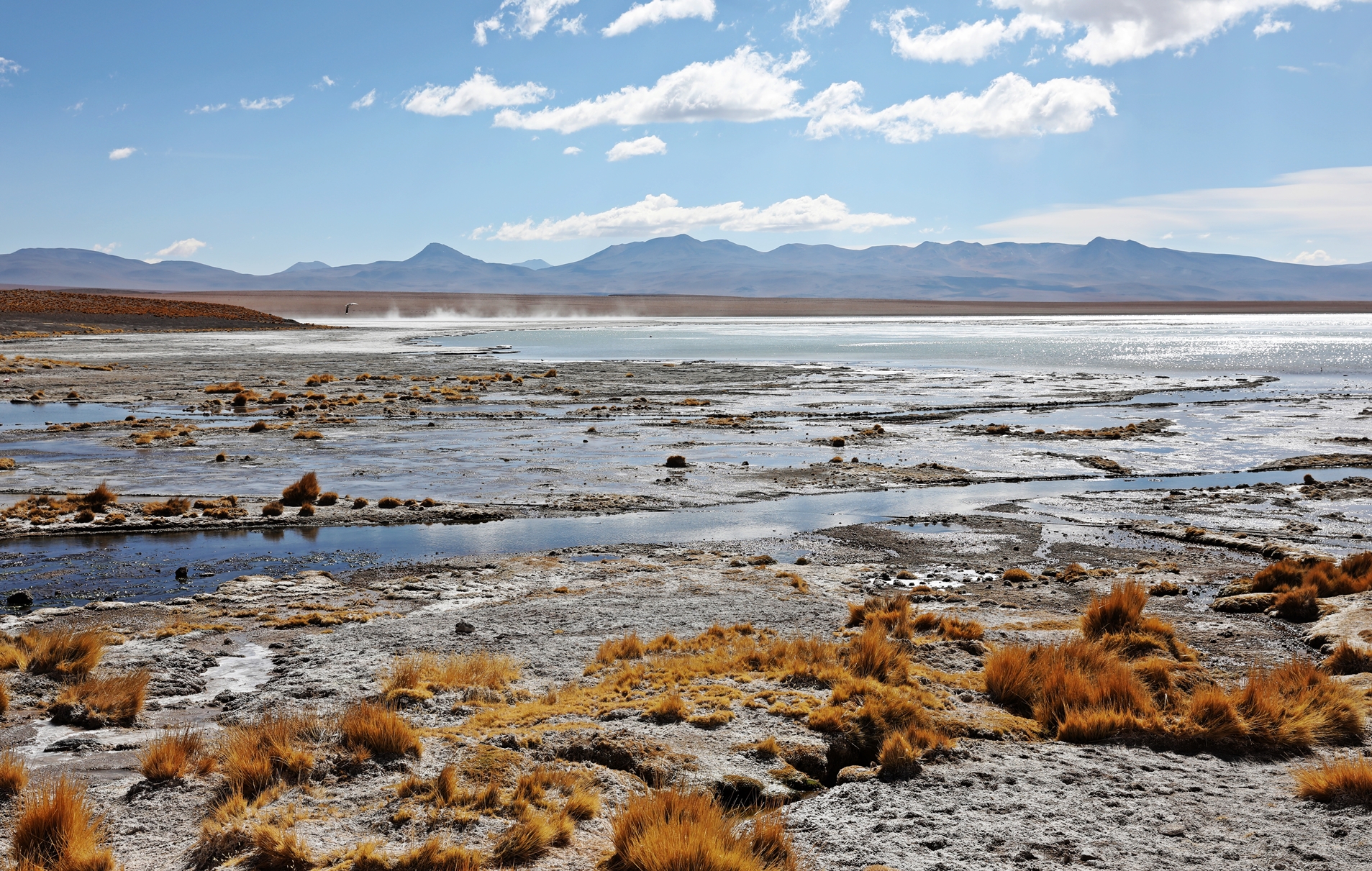
Unlike Laguna Chalviri most of the lakes in this area are better enjoyed from shore because of their high mineral content. The first of these that we visited was a small unnamed lake surrounded by desert hills. What made it special was the flock of pink flamingos wading in its waters. Even though the air temperatures are below freezing and the lakes are full of minerals, flamingos flock to this region to feast on the plankton and algae in the lakes.


Laguna Chulluncani
The next lake we visited has a picture-perfect setting at the base of Volcan Chulluncani. There were dozens of pink flamingos wading in the shallow, murky waters of the Laguna Chulluncani. The water is filled with minerals including salt and boron. It is the minerals that give the water its cloudy appearance.
At first we thought there were chunks of ice along the shore. When we got closer we realized they were actually mineral deposits. Later we learned they were in fact piles of borax. The scene with the flamingos, the mineral lake and the volcano was almost too good to be true.

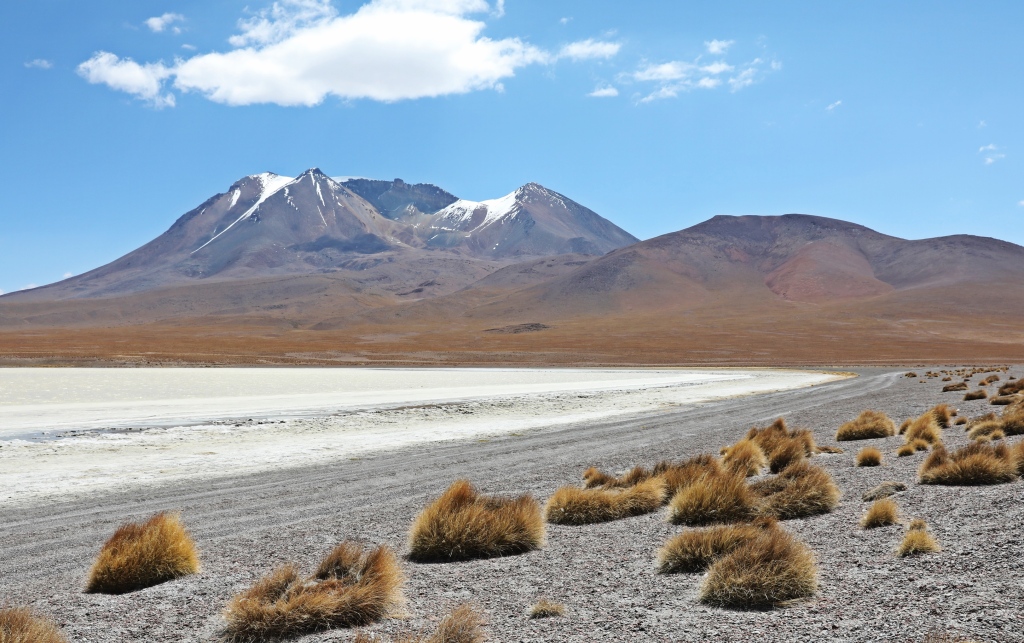
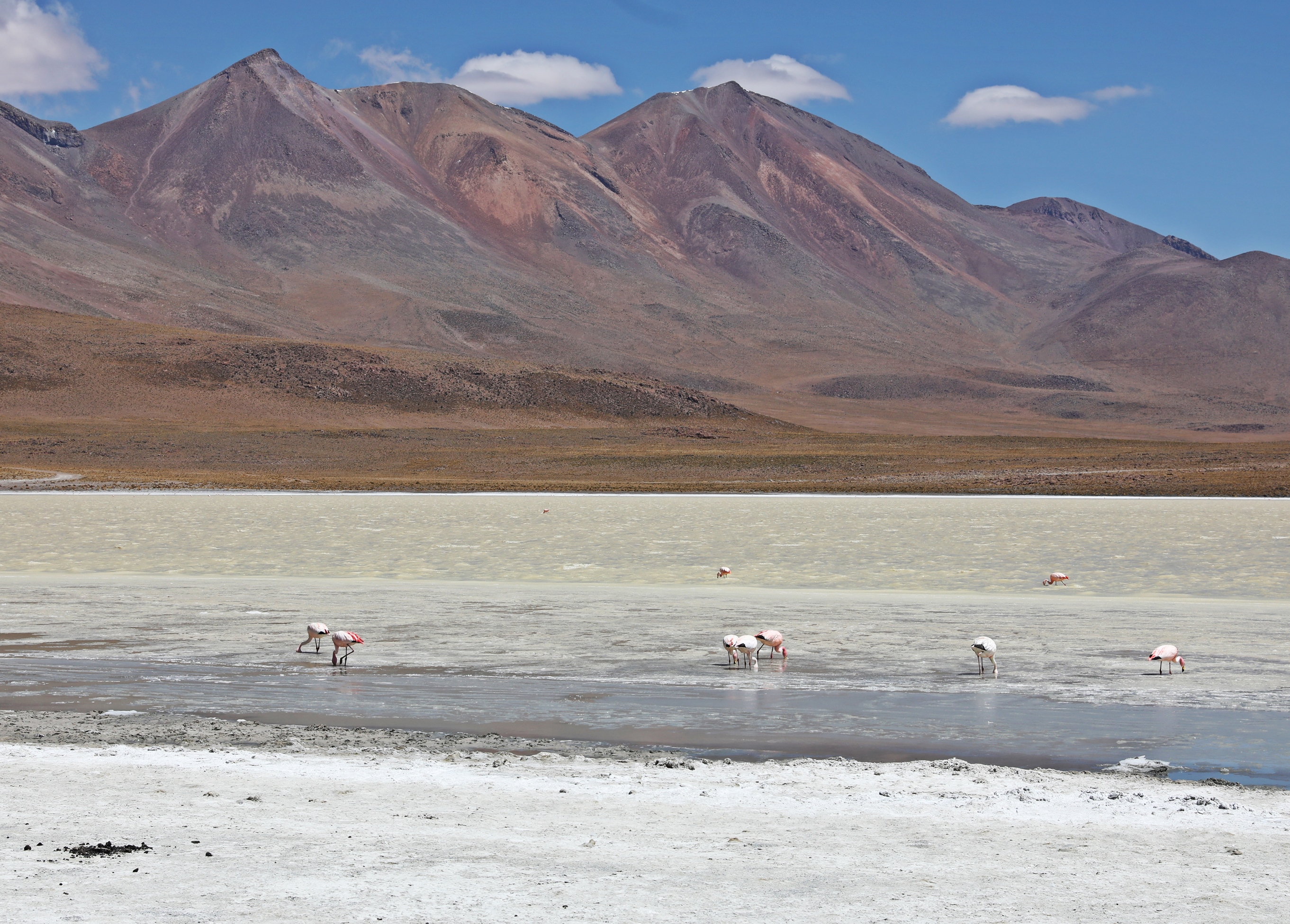

Laguna Cache
There are no actual roads beyond Laguna Chulluncani. With only the tracks of other 4WDs to follow our driver weaved between small volcanos while driving on the flat gravel terrain. In addition to Salar de Uyuni there are many other salt flats in the area. On the drive we passed a few surface mines where they were harvesting the valuable minerals.
Finally we arrived at Laguna Cache. We were told that the lake has a high content of boron so we didn’t expect to find any wildlife. Surprisingly though, walking in the boron filled lake were hundreds of pink flamingoes.


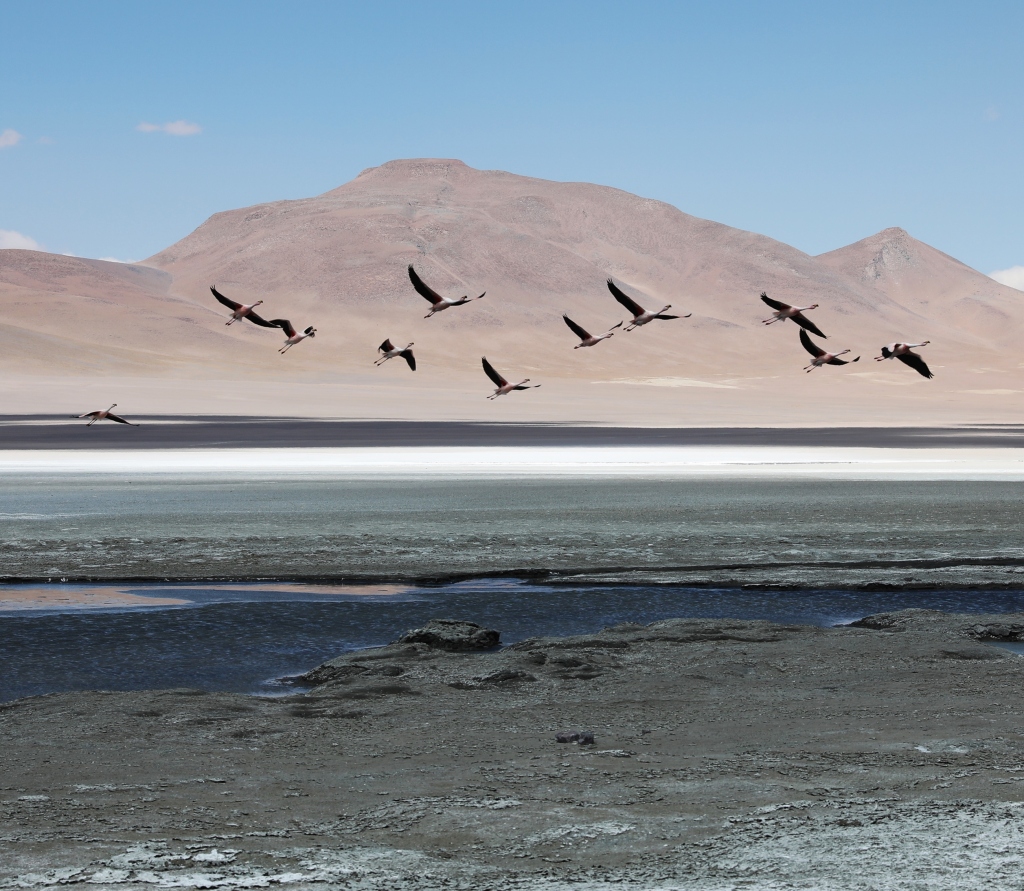

Laguna Kara
Back on the lack-of-road again, the flat terrain turned to hills. From a distance we thought the hills were sand dunes, but they turned out to be hard gravel. The 4WD drove up and down the hills with ease. The strange landscape made it feel like we were driving on the undulating ocean floor.
Seemingly in the middle of nowhere we came across another unimaginable scene. Laguna Kara is a gorgeous mineral lake and like the others, was filled with flamingoes. With each lake we visited it became more and more windy, and more and more cold. We went to the top of a small hill above Laguna Kara for a gorgeous view of the lake amidst dozens of volcanos. It was too cold to stay and admire it for long though.

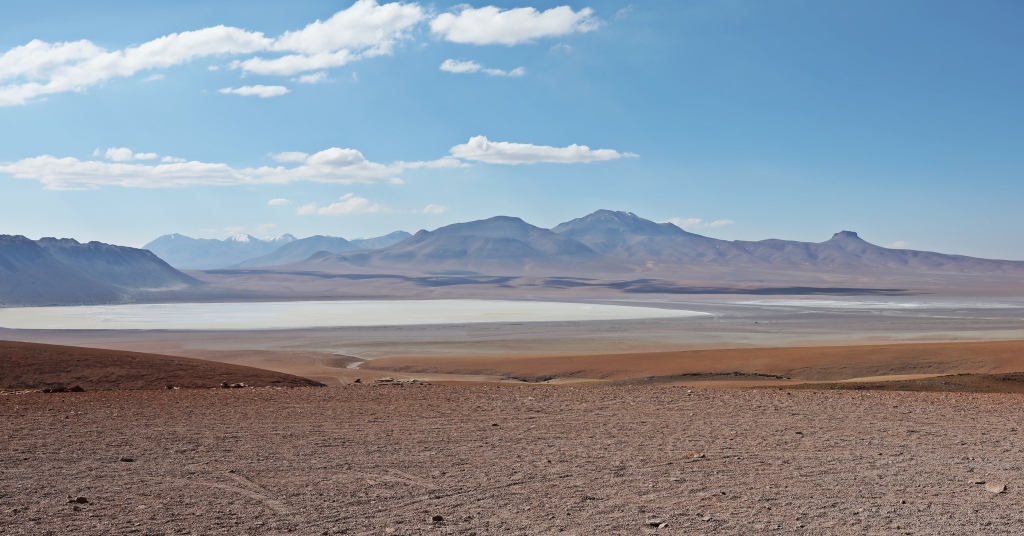
Laguna Colorada (Red Lake)
The splendor of Laguna Colorada is not visible on the approach. In fact we were a little disappointed when we first saw a small lake with water that could hardly be called red. Then we realized that we were only seeing a small section of the famous lake. A small pinnacle juts out into the water, almost splitting the lake into two and hides its most impressive side.
A short trail took us to the top of a hill on the pinnacle where we looked upon an inconceivable landscape. It is difficult to say which part of the scene was more spectacular; the brilliant red water that fills the large lagoon or the thousands of flamingos that waded in its depths. Adding contrast to the red lake were large areas with white borax ‘icebergs’. Topping it off, this surreal scene is located at the base of the imposing Chi’qu Volcano. This is one of the most remarkable, otherworldly sites we’ve ever seen.
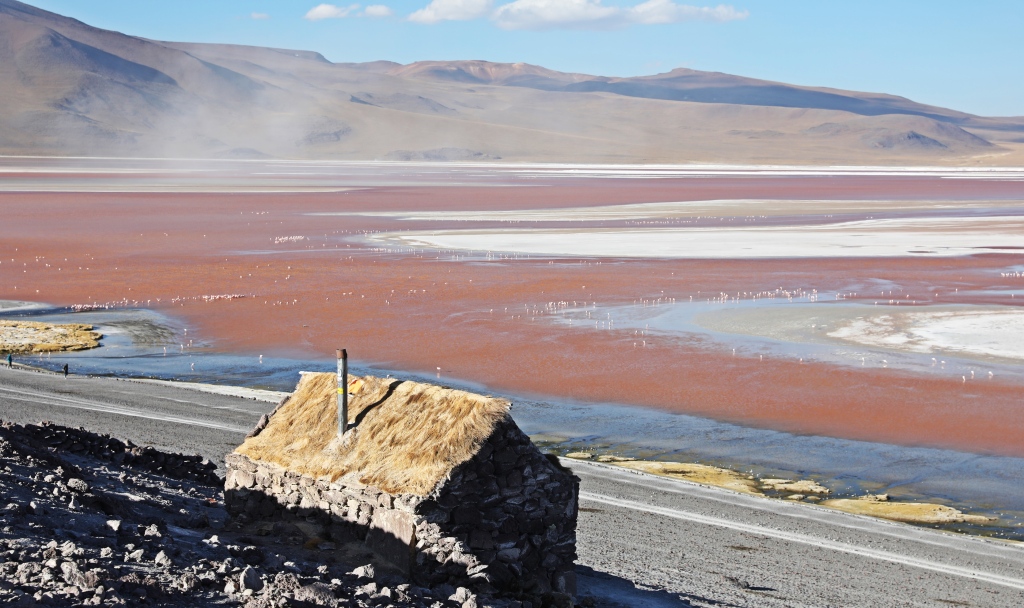


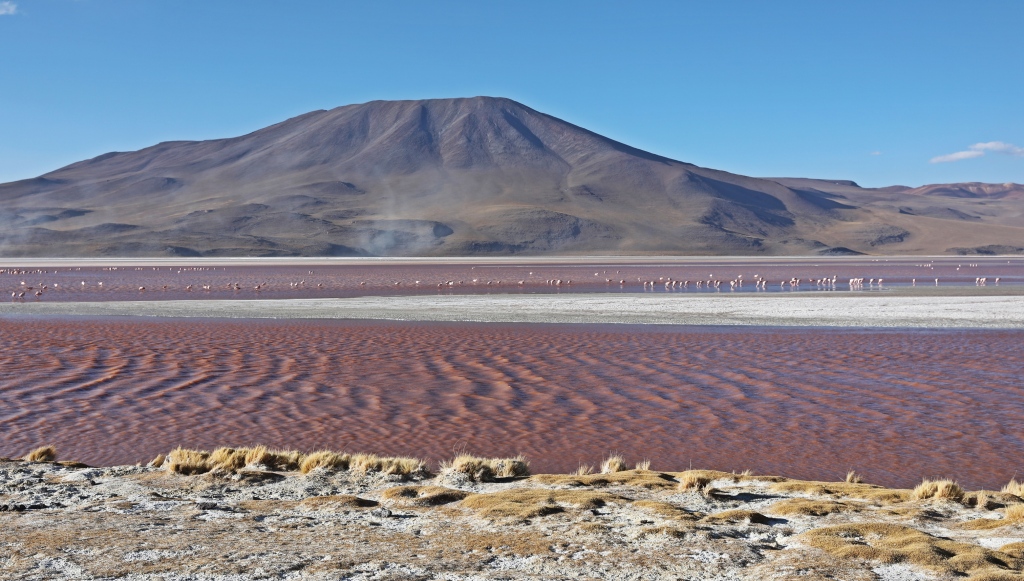
The red colour comes from algae in the water, which is what the birds like to eat. There are three types of flamingoes in this area and we could see all three in this lake. The Andean, James and Chilean Flamingos each have different colourings on their beaks, wings, knees and feet. The water is only 1 meter deep so flamingos could be seen wading across the entire lake.




We saw a lot of vicunas, wild camelids, while traveling between the lakes. Most of them were very skittish and would quickly run away when we got too close. Richard learned how to be very stealthy and was able to take a few amazing pictures of the vicunas.


Laguna Verde (Green Lake)
Before reaching Laguna Verde we stopped at the large Laguna Blanca (White Lake). This lake has no outflow and therefore retains all its water. The white colour comes from a high concentration of borax.

Right beside Laguna Blanca is the colourful Laguna Verde. Its bright green water and white borax shore looks like a postcard. The lake is set below Licancabur Volcano which lies on the Bolivian – Chilean border. The green colour comes from arsenic that is in the lake. The arsenic content is also the reason that there are no flamingos or other wildlife here.
The winds at Laguna Verde were the strongest that we experienced on the tour. Maggie could barely open the car door because the wind was pushing against it so hard. Apparently strong winds will blow borax from Laguna Blanca on to Laguna Verde and affect its colour which is what happened when we were there. The lake colour can vary from emerald green to tuquoise, but no matter the shade it is a spectacular spot.
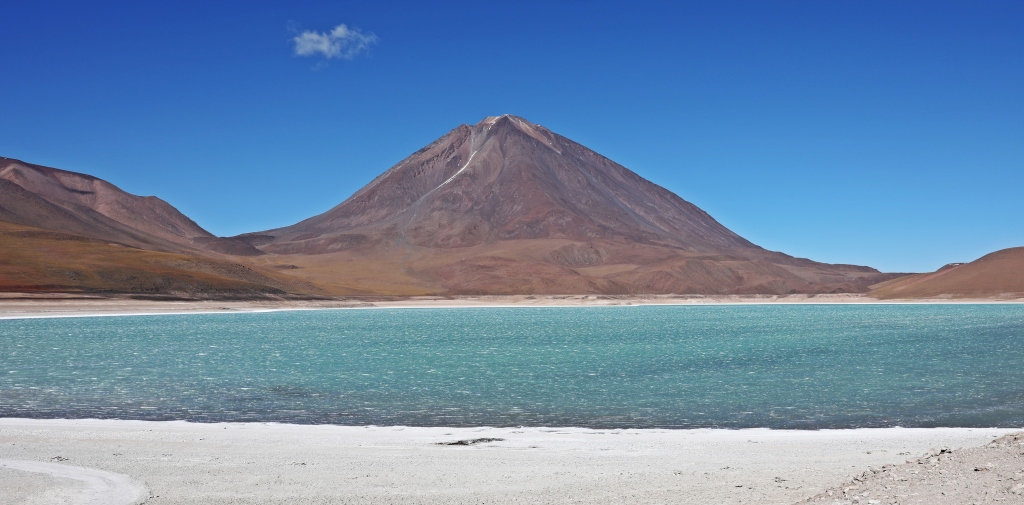

Laguna NegrA (Black Lake)
Before returning to Uyuni, our guide asked if we wanted to make a small detour to visit another lake. We really knew nothing about Laguna Negra but agreed on the detour. Are we ever glad we did. After getting out of the car, we walked by a herd of grazing llamas. That alone made the stop worthwhile. Then we walked between red granite walls that concealed a hidden gem.

Behind the granite walls is a fantastic site. We found a small idyllic lake, surrounded by tall red granite cliffs. On the edge of the peaceful lake, ducks were nesting in the reeds. A large meadow on the far side of the lake was filled with hundreds of llamas. Laguna Negra was one of the prettiest spots on the whole tour. We think our guide always intended to stop but pretended that it was an extra surprise.



When to visit
Like many things it depends on what you want to see. For clear skies and dry roads the best time to visit is during dry season from May to November. Remember that from June to August it’s winter and the temperatures will be much lower. During rainy season the salt flats are covered in a thin layer of water and becomes a huge mirror. It is a popular time to visit, but the water means some of the other sites around the salt flats are inaccessible. To see the mirror effect on the salt flats visit between January and March.
Uyuni and surrounding areas are located at very high elevations. Be sure to give yourself time to acclimatize so can enjoy the landscapes without suffering from the effects of high altitude.
About the tours
In order to explore everything that Uyuni has to offer you need to take a tour. There are one-day tours to the salt flats, but you wouldn’t get to see any of the other amazing landscapes. Because of the distances between sites, two-day tours wouldn’t allow you to see much more. We took a 3 day/2 night tour and felt that was the perfect amount of time to fully explore many of the sites around Uyuni.
Many tours can be bought in advance on-line but prices for these will be higher. We booked our tour from an office in Uyuni one day before our trip and paid only 700 Bolivianos each for 3 days/2 nights, including all meals, hotels and transportation/guide.
Where to stay
The city of Uyuni is the most common starting point for tours of the salt flats and lakes. There are several basic hotels and restaurants that are fine for a night. There’s not much to do in town so don’t plan to spend more time than necessary in Uyuni.
If you’re coming from Argentina you may want to take a tour from Tupiza instead (read our post here). The tour would go in the reverse direction of the lakes described above and end at Salar de Uyuni.
To read about our other adventures in Bolivia click here.
Coming Next – Bolivian Wine Country
For pictures from other blogs go to Gallery at monkeystale.ca
To read about more of our adventures go to Destinations.
If you like what you read, please comment or share (with credit) using the links below
I remember the boxes of “20-Mule Team Borax” mom used to buy for laundry duty. Did the lakes have pungent sulphur or rotten egg odor? As always, the photography is amazing.
LikeLiked by 2 people
The only lake that smelled was the one with the hot springs. The others didn’t at all, maybe because the winds were so ferocious they swept the odors away, or maybe only sulphur has a strong smell. Maggie
LikeLiked by 1 person
This would be similar to Yellowstone’s pools.
LikeLiked by 1 person
Another stunning selection of images! I love the blue of Black Lake! 🙂
LikeLiked by 2 people
Haha, so true, it wasn’t black at all but was a much darker colour than any of the others so maybe that’s how it got the name. 🙂
LikeLiked by 1 person
It is certainly a name that has been bandied about a lot! We have a few Black Mountains here and it is only on the most cloudy day does it deserve that epithet!
LikeLiked by 1 person
Wonderful photos. Happy Friday My Friend.
A red rose
Placed in a vase
Fragrance fills the room
– iku
LikeLiked by 1 person
Thanks so much Goff, Happy Friday to you too 🙂
LikeLike
You were right, this was worth waiting for! Absolutely stunning 😮 In places it reminds me of the Salar de Atacama in Chile (we even saw the same volcano, Licancabur, I think, from the other side) but Laguna Colorada in particular seems to beat anything we saw there, as does Laguna Negra. Spectacular!
LikeLiked by 2 people
Yes, I’ve never seen anything close to Laguna Colorada. It’s surreal and beautiful at the same time. We didn’t go to the Chile side, maybe next time. Thanks for your comments Sarah.
LikeLiked by 1 person
These sceneries are breathtaking, Thanks for sharing so many wonders with us
LikeLiked by 1 person
Thank you Luisa 🙂 Maggie
LikeLiked by 1 person
You’re more than welcome, dearest Maggie 😘😘😘
LikeLiked by 1 person
I’m running out of words in my responses to these posts about such stunning places. You must have been just completely awestruck to stand stare at those lakes (perhaps especially the red algae coloured lake) plus the flamingos plus the volcano backdrops. What an incredible place.
LikeLiked by 2 people
Yes, I was running out of words to describe them too. They are truly beyond anything I’ve ever seen before, or even imagined before. It was also difficult to narrow down the pictures because we couldn’t stop taking them 🙂 Maggie
LikeLiked by 1 person
I’m running out of words as well…lovely!
LikeLiked by 2 people
🙂 Thanks June
LikeLike
Surreal scenery. We would absolutely love to visit this area. Laguna colorada is stunning with the red water, a volcano looming in the distance and flocks of flamingos. Picture book stuff.
LikeLiked by 2 people
It is quite the unbelievable scenery. Individually each would be great, but together they are beyond belief. You really should consider a visit to Bolivia. Thanks again for sharing your thoughts Leighton 🙂 Maggie
LikeLiked by 1 person
Love your images. It could be an alien planet. What a wonderful experience Bolivia has been for you.
LikeLiked by 2 people
Thanks Kerry, It did feel like we woke up on another planet, so different from anywhere else we’d seen:) Maggie
LikeLiked by 1 person
Oh my gosh. You’re right; I’m ready to book a plane ticket right now. This is incredible! I can’t believe scenes like this exist, especially all the different colors and minerals in the same region. Bolivia has just moved a whole lot higher up on my bucket list.
LikeLiked by 2 people
Being a lake lover I thought you’d like this one. Not only is there one bizarre lake but in one afternoon you see so many and they’re all so unique and incredible! Start booking 🙂 Maggie
LikeLiked by 1 person
What interesting places you are sharing. Thanks.
LikeLiked by 2 people
Yes, there are so many fascinating places in Bolivia. Thanks for reading 🙂 Maggie
LikeLiked by 1 person
Just wow. Again. 🙂
We’re all running out of superlatives!
LikeLiked by 1 person
Haha, yes me included 🙂
LikeLiked by 1 person
fantastic
▪◾◼◾▪▫◽◻◽▫▪◾◼◾▪▫◽◻◽▫▪◾◼◾▪
▫◽◻◽▫▪◾◼◾▪▫◽◻◽▫▪◾◼◾▪▫◽◻◽▫
LikeLiked by 1 person
Thanks so much Graham 🙂 Maggie
LikeLiked by 1 person
😌🙏✨
LikeLike
I love the Black Lake photos, and the rock formations there; so interesting! It’s always a thrill to see wild life in their natural habitats. Great post!
LikeLiked by 1 person
Thanks, Laguna Negro is such a pretty lake. Thanks for taking the time to comment! M
LikeLiked by 1 person
When we next go to Peru we will definitely have to hop over and check out this region, its stunning! X
LikeLiked by 1 person
Yes you do. There’s a reason it’s one of the most visited places in Bolivia., it’s quite amazing.
LikeLiked by 1 person
The landscape is just wow! So surreal!
LikeLiked by 1 person
Yes it’s really unbelievable, thanks for taking the time to comment 😊 Maggie
LikeLike
Wow, the scenery is surreal, and you have really captured all the areas so beautifully that the photos make me want to visit.
LikeLiked by 1 person
Thanks Nat, it’s a bizarre and beautiful place! Maggie
LikeLiked by 1 person
Truly stunning
LikeLiked by 1 person
Thank you, it is an amazing place 😊
LikeLiked by 1 person
Thank you, it’s a beautiful place.
LikeLiked by 1 person
Awesome sight! We have loads of flamingos here too but that backdrop is stunning.
LikeLiked by 1 person
Seeing the flamingos in the strange lakes was an unbelievable view. Tha nks for taking the time to comment Jo! Maggie
LikeLike
🤗💗
LikeLike
So much for the idea that flamingos were warm weather, sea level creatures. But if you’re going to go for surreal, I guess you also need seagulls that use borax for antifreeze.
LikeLiked by 1 person
Er, I mean flamingos that use borax for antifreeze…
LikeLiked by 1 person
Ha yes if you’re going for surreal, go all out!
LikeLiked by 1 person
What an amazing number of lakes around there! Usually, you think of that area as high and dry!
LikeLiked by 1 person
Yes, it almost is dry with the salt flats dried up but these other strange lakes have survived somehow. 😊
LikeLiked by 1 person
Now I understand why you went to Salar de Uyuni when it was dry, so that you could see these other beautiful lagunas. I must say if no one told me about what gives Laguna Verde its color, I would be tempted to dip my toes in it! It looks so refreshing. These are really breathtaking landscapes, Maggie.
LikeLiked by 1 person
It looks refreshing but the +100 km/hr winds and below 0C temperatures would quickly change your mind, that and the arsenic of course 😊
LikeLiked by 1 person
The landscapes are beautiful and otherworldly, but the most amazing thing to me is how the animals, particularly the flamingoes, have adapted to their habitat with all the minerals, cold, etc. I’d love to see all this for myself someday!
LikeLiked by 1 person
It’s really remarkable isn’t it. I read that sometimes the water will freeze around them over the night and they patiently wait for it to melt the next day before moving! Keep it on your list, it’s one that lives up to expectations. Maggie
LikeLiked by 1 person
Oh, strong winds and a temperature of -20°C … sounds way too cold for my liking! But it still is beautiful – especially with the elegant flamingos in the lake. All of these lakes are stunning, but I like the look of Laguna Colorada – the red is vivid and the flamingos really adds to the beauty! But I also like the Green lake and your hidden gem, Laguna Negro. Oh well, I suppose I like them all 😉.
LikeLiked by 1 person
Haha ya it’s sometimes hard to chose, they’re all so different.😊
LikeLiked by 1 person
What expansive and beautiful landscapes! Our home on Planet Earth is beautiful beyond our imagination. Let us take care of her.
LikeLiked by 1 person
That’s very true, I wouldn’t be able to come up with many of the perfect scenes. Thanks for taking the time to comment Rosaline, Maggie
LikeLiked by 1 person
These are amazing images. These lakes are so amazing. Anita
LikeLiked by 1 person
It is a gorgeous part of Bolivia, thanks for taking the time to comment Anita, Maggie
LikeLike
WOW! Even more beauty. It’s a hard kind of beauty, but stunning all the same. Thanks for the inspiration. Mel
LikeLiked by 1 person
It is oddly beautiful. Like an abstract painting that you don’t understand 😊 Maggie
LikeLiked by 1 person
I like it. Nature’s painting at its finest. Mel
LikeLiked by 1 person
Hard to keep up with you travels, since you have been to so many fantastic places recently. Great photos and information as usual, but I wonder how you can digest so many experiences in such a “short” time.
LikeLiked by 1 person
My goodness that is a lot of flamingos! What I really love is that the flamingos seem so out of place with the rugged surroundings- like this wonderful juxtaposition of different worlds. 🙂
LikeLiked by 1 person
That’s so true, they do seem out of place. Where you think nothing would live, you certainly don’t expect flamingos!
LikeLiked by 1 person
Such an unusual place to explore… and the flamingo! Thanks for sharing this one. I had no idea about this place.
LikeLiked by 1 person
Thanks Ruth, it is a beautiful and bizarre sight to see, the fmalingos top it off. Thanks for visiting. Maggie
LikeLiked by 1 person
Incredible landscapes, beautiful.
LikeLike
Beautiful capture of all these lakes, I would have also wanted to make more photographs but the icy cold of the wind incites quickly to go back in the car. The places to spend the night are very spartan and cold. I’ve seen more luxurious hotels, but that’s pretty relative.
LikeLike
there’s something amazing about the Flamingoes. These lakes out in the middle of nowhere with near nil vegetation, and yet there they are! it almost defies logic!
LikeLiked by 1 person
It really does. It’s so illogical and yet so perfect. 😊
LikeLike
Wow, these places are absolutely stunning! I feel like the flamingos also are the perfect addition to these seemingly untouched places. I have always wanted to see the Salar de Uyuni but didn’t know about all of these other places. I really hope I’ll get to see them with my own eyes one day. In the meantime, thanks for taking us with you!
LikeLiked by 1 person
Thank you so much! The entire landscape around the salt flats are as impressive or maybe even more than the salt flats themselves. It is definitely worth a visit. Thanks so much for reading and taking the time to comment. Maggie
LikeLiked by 1 person
“Remarkable” and “otherworldly” indeed. And to see the flamingoes in this surreal setting must have been even more incredible.
LikeLiked by 1 person
It really is an unbelievable landscape and seeing flamingos made it even more incredible. Thanks for your comments Tanja. Maggie
LikeLiked by 1 person
Thanks for transporting me to a different world!
LikeLike
Just got back back from a 4×4 trek across the Uyuni Salt Flats and Atacama Desert. Simply out of this world landscape.
LikeLiked by 1 person
It’s unreal isn’t it?! Did you do a post about it? I’ll have a look at your site. Maggie
LikeLike
So unreal. I did a post on Uyuni and will do a subsequent one on the Atacama.
LikeLiked by 1 person
Wow, that’s a lot of flamingos, Maggie! Seems like breathtaking vistas greet intrepid travellers at seemingly every turn in Bolivia. Thanks for sharing and take care 🙂 Aiva xx
LikeLiked by 1 person
Bolivia really surprised us with so many varied landscapes. We spent two months there and we had something new every few days. Maggie
LikeLiked by 1 person